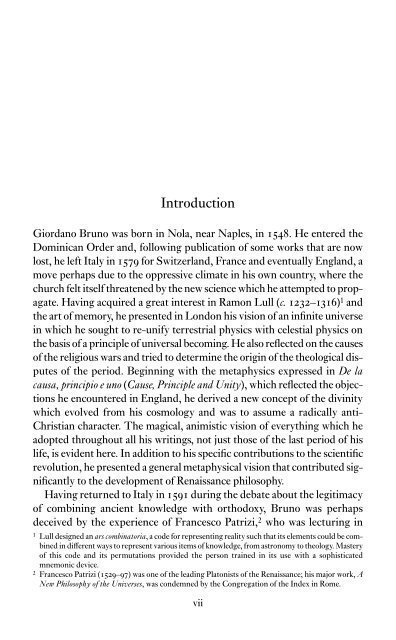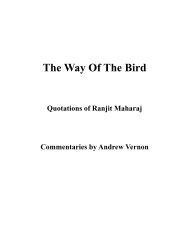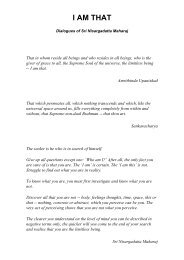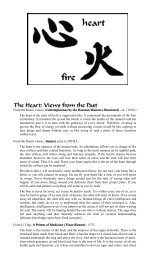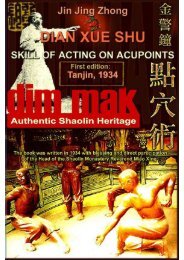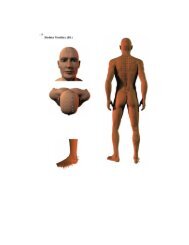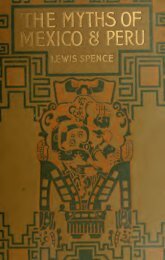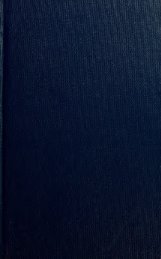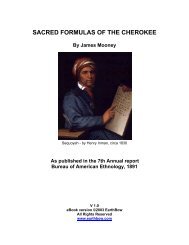- Page 2 and 3: This page intentionally left blank
- Page 4 and 5: CAMBRIDGE TEXTS IN THE HISTORY OF P
- Page 6 and 7: PUBLISHED BY THE PRESS SYNDICATE OF
- Page 10 and 11: Introduction Platonic philosophy at
- Page 12 and 13: Introduction beyond the imaginary l
- Page 14 and 15: Introduction from the pure act cons
- Page 16 and 17: Introduction development of thought
- Page 18 and 19: Introduction between the unity of t
- Page 20 and 21: Introduction and qualities, and doe
- Page 22 and 23: Introduction V Bruno’s originalit
- Page 24 and 25: Introduction process, eventually ca
- Page 26 and 27: Introduction The action of the magu
- Page 28 and 29: Introduction The point of distincti
- Page 30 and 31: Introduction fact remains that it p
- Page 32 and 33: Chronology 1548 Born at Nola, near
- Page 34 and 35: Chronology left vacant since 1588 (
- Page 36 and 37: Further reading The Latin works of
- Page 38 and 39: Note on the texts Cause, Principle
- Page 41 and 42: Prefatory Epistle Addressed to the
- Page 43 and 44: Prefatory epistle Here, then, is th
- Page 45 and 46: Prefatory epistle determines matter
- Page 47 and 48: Prefatory epistle taken from the fa
- Page 49 and 50: Prefatory epistle whence proceed th
- Page 51 and 52: Prefatory epistle Mens, cognata voc
- Page 53 and 54: First dialogue con senso, con raggi
- Page 55 and 56: First dialogue ulated sounds like m
- Page 57 and 58: First dialogue of having attended i
- Page 59 and 60:
First dialogue ARMESSO. To be casti
- Page 61 and 62:
First dialogue find you a bit exces
- Page 63 and 64:
First dialogue Senate, which, if it
- Page 65 and 66:
First dialogue of his sermon some f
- Page 67 and 68:
First dialogue distinctions, give d
- Page 69 and 70:
First dialogue as happy with his ac
- Page 71 and 72:
Second dialogue find a man who surp
- Page 73 and 74:
Second dialogue substance of that m
- Page 75 and 76:
Second dialogue DICSONO. Then, tell
- Page 77 and 78:
Second dialogue extended, as if it
- Page 79 and 80:
Second dialogue character of an eff
- Page 81 and 82:
Second dialogue universe of which,
- Page 83 and 84:
Second dialogue being dominated by
- Page 85 and 86:
Second dialogue that exists only in
- Page 87 and 88:
Second dialogue DICSONO. So that, i
- Page 89 and 90:
Third dialogue POLIINNIO. That magi
- Page 91 and 92:
Third dialogue the properties of dr
- Page 93 and 94:
Third dialogue DICSONO. Good. Let m
- Page 95 and 96:
Third dialogue stone, wool and the
- Page 97 and 98:
Third dialogue GERVASIO. He may per
- Page 99 and 100:
Third dialogue DICSONO. Then, he se
- Page 101 and 102:
Third dialogue should not fault tha
- Page 103 and 104:
Third dialogue no better than those
- Page 105 and 106:
Third dialogue sometimes they confo
- Page 107 and 108:
Third dialogue have scandalized cer
- Page 109 and 110:
Fourth dialogue vocula), a melius r
- Page 111 and 112:
Fourth dialogue GERVASIO. Why do yo
- Page 113 and 114:
Fourth dialogue genus, so the forms
- Page 115 and 116:
Fourth dialogue some ways divisible
- Page 117 and 118:
Fourth dialogue acquiring dimension
- Page 119 and 120:
Fourth dialogue matter produces for
- Page 121 and 122:
Fourth dialogue it is ‘that thing
- Page 123 and 124:
Fourth dialogue permanent; later on
- Page 125 and 126:
TEOFILO. Then, goodbye. Fifth dialo
- Page 127 and 128:
Fifth dialogue status as point, it
- Page 129 and 130:
Fifth dialogue one, nor being, nor
- Page 131 and 132:
Fifth dialogue member, the whole, e
- Page 133 and 134:
Fifth dialogue of measure cannot be
- Page 135 and 136:
Fifth dialogue (as the Cusan 8 , th
- Page 137 and 138:
Fifth dialogue has reached that poi
- Page 139:
Fifth dialogue TEOFILO. The decade
- Page 143 and 144:
On magic As with any other topic, b
- Page 145 and 146:
On magic and also from the appearan
- Page 147 and 148:
On magic are not equal. For light d
- Page 149 and 150:
On magic of liquids which form a sp
- Page 151 and 152:
On magic Furthermore, the soul, in
- Page 153 and 154:
On magic resulted in a tremendous l
- Page 155 and 156:
On magic spiritual body is the same
- Page 157 and 158:
On magic or around a centre. Rather
- Page 159 and 160:
On magic well disposed to become fl
- Page 161 and 162:
On magic rather moves away, for thi
- Page 163 and 164:
On magic prayers. Rather, they free
- Page 165 and 166:
On magic Cicada, 17 which was once
- Page 167 and 168:
On magic Finally, it must be consci
- Page 169 and 170:
8. The divine names and the names o
- Page 171 and 172:
On magic happens to sea water, whic
- Page 173 and 174:
On magic things do not have their o
- Page 175 and 176:
On magic approached him with humour
- Page 177 and 178:
On magic twofold. Sometimes the age
- Page 179 and 180:
On magic he himself belongs to the
- Page 181:
A General Account of Bonding
- Page 184 and 185:
A general account of bonding force
- Page 186 and 187:
A general account of bonding 8. Wha
- Page 188 and 189:
A general account of bonding reason
- Page 190 and 191:
A general account of bonding body u
- Page 192 and 193:
A general account of bonding antece
- Page 194 and 195:
A general account of bonding 7. Tal
- Page 196 and 197:
A general account of bonding 7. The
- Page 198 and 199:
A general account of bonding divers
- Page 200 and 201:
A general account of bonding I conf
- Page 202 and 203:
A general account of bonding variou
- Page 204 and 205:
A general account of bonding third
- Page 206 and 207:
A general account of bonding speech
- Page 208 and 209:
A general account of bonding prefac
- Page 210 and 211:
A general account of bonding lacks
- Page 212 and 213:
A general account of bonding then t
- Page 214 and 215:
A general account of bonding thus,
- Page 216 and 217:
Index on matter xviii, 9, 80, 172 r
- Page 218 and 219:
Index see also art Culpepper, Marti
- Page 220 and 221:
Index mathematical magic xxiii, 105
- Page 222 and 223:
Index see also world-soul sound ani
- Page 224:
Cambridge texts in the history of p


